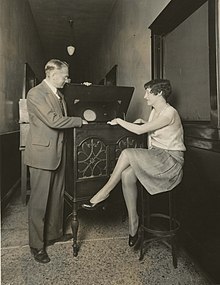History of Television § Broadcasting
Mechanical
By the 1920s, when amplification made television practical,
Scottish inventor John Logie Baird employed the Nipkow disk in
his prototype video systems. On 25 March 1925, Baird gave the first public
demonstration of televised silhouette images in motion, at Selfridge’s Department
Store in London.Since human faces had inadequate contrast to show up on his
primitive system, he televised a ventriloquist's dummy named "Stooky
Bill", whose painted face had higher contrast, talking and moving. By 26
January 1926, he demonstrated the transmission of the image of a face in motion
by radio. This is widely regarded as the first television demonstration. The
subject was Baird's business partner Oliver Hutchinson. Baird's system used the
Nipkow disk for both scanning the image and displaying it. A bright light
shining through a spinning Nipkow disk set with lenses projected a bright spot
of light which swept across the subject. A Selenium photoelectric tube detected
the light reflected from the subject and converted it into a proportional
electrical signal. This was transmitted by AM radio waves to a receiver unit,
where the video signal was applied to a neon light behind a second Nipkow disk
rotating synchronized with the first. The brightness of the neon lamp was
varied in proportion to the brightness of each spot on the image. As each hole
in the disk passed by, one scan line of the image was reproduced.
Baird's disk had 30 holes, producing an image with only 30 scan lines, just
enough to recognize a human face. In 1927, Baird transmitted a signal over 438
miles (705 km) of telephone line between London and Glasgow.
In
1928, Baird's company (Baird Television Development Company/Cinema Television)
broadcast the first transatlantic television signal, between London and New
York, and the first shore-to-ship transmission. In 1929, he became involved in
the first experimental mechanical television service in Germany. In November of
the same year, Baird and Bernard Natan of Pathe established France's
first television company, Télévision-Baird- Natan. In 1931, he made the first
outdoor remote broadcast, of The Derby. In 1932, he
demonstrated ultra-short wave television. Baird's mechanical system
reached a peak of 240-lines of resolution on BBC television broadcasts in
1936, though the mechanical system did not scan the televised scene directly.
Instead a 17.5mm film was shot, rapidly developed and then scanned while
the film was still wet.
An
American inventor, Charles Francis Jenkins, also pioneered the television.
He published an article on "Motion Pictures by Wireless" in 1913, but
it was not until December 1923 that he transmitted moving silhouette images for
witnesses; and it was on 13 June 1925, that he publicly demonstrated
synchronized transmission of silhouette pictures. In 1925 Jenkins used
the Nipkow disk and transmitted the silhouette image of a toy
windmill in motion, over a distance of five miles, from a naval radio station
in Maryland to his laboratory in Washington, D.C., using a lensed disk scanner
with a 48-line resolution. He was granted U.S Patent No. 1,544,156
(Transmitting Pictures over Wireless) on 30 June 1925 (filed 13 March 1922).
Because only a limited number of holes could be
made in the disks, and disks beyond a certain diameter became impractical,
image resolution on mechanical television broadcasts was relatively low,
ranging from about 30 lines up to 120 or so. Nevertheless, the image quality of
30-line transmissions steadily improved with technical advances, and by 1933
the UK broadcasts using the Baird system were remarkably clear. A few
systems ranging into the 200-line region also went on the air. Two of these
were the 180-line system that Compagnie des Compteurs (CDC) installed in Paris
in 1935, and the 180-line system that Peck Television Crop started
in 1935 at station VE9AK in Monteral The advancement of
all-electronic television (including image dissectors and other camera tubes
and cathode ray tubes cathode ray tube for the reproducer)
marked the beginning of the end for mechanical systems as the dominant form of
television. Mechanical television, despite its inferior image quality and
generally smaller picture, would remain the primary television technology until
the 1930s. The last mechanical television broadcasts ended in 1939 at stations
run by a handful of public universities in the United States.




Comments
Post a Comment